Table of Contents
CHAPTER 11
INTEGRATED METHODS OF ADVERTISING
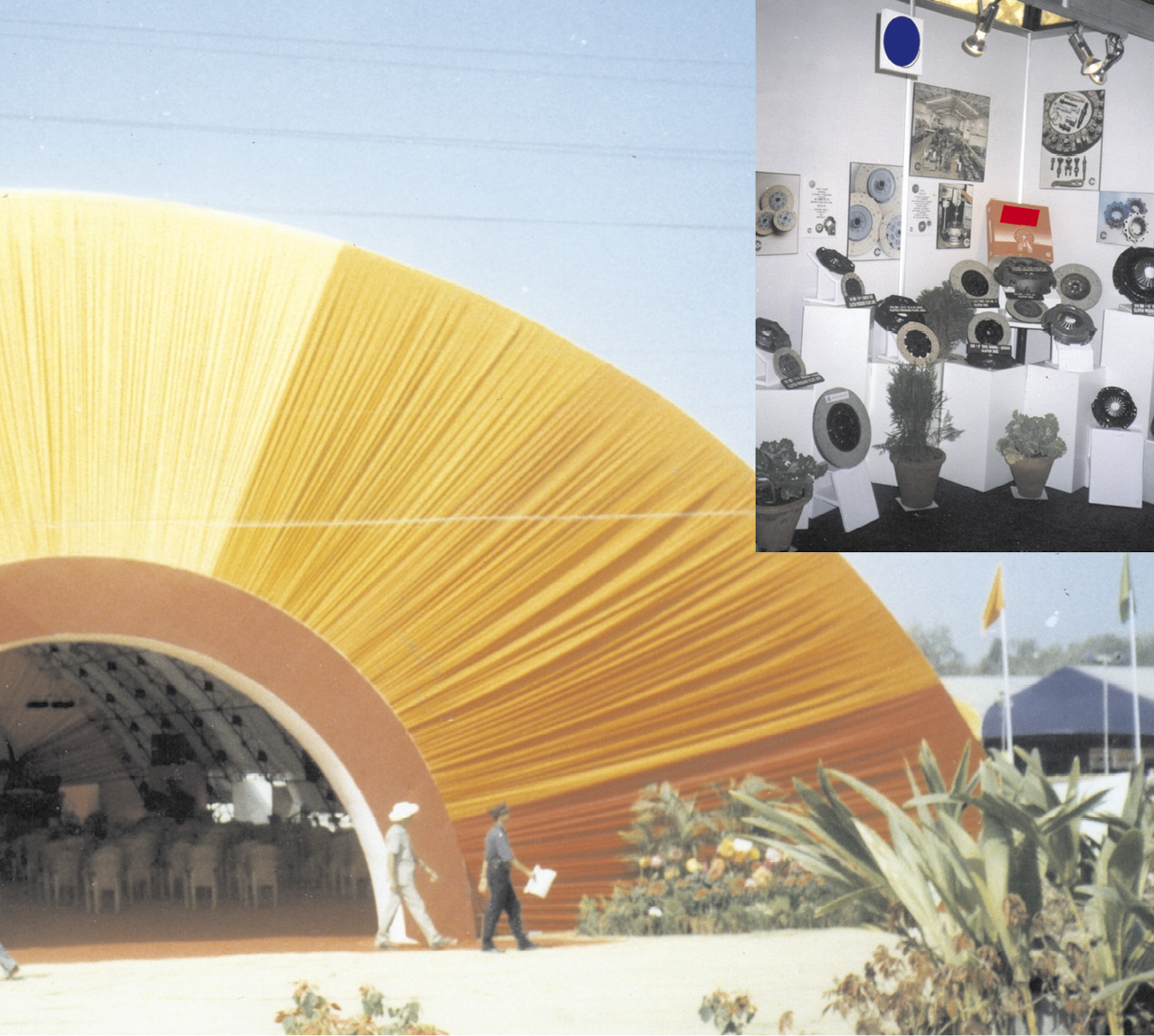
There are many different ways to augment actual advertising and marketing techniques. That means such efforts by any company don’t directly sell a product or service, but promote it nevertheless. Either the publicity materials carry a line saying that …’this programme is brought to you by the makers of…’ followed by the product name. Or it will say: ‘this event is sponsored by THE TASTE OF INDIA…’ followed by the product or brand name. But beyond that these events or programmes do not normally highlight the salient features of the product. These are thus known as integrated methods of advertising as they support the main campaign, they include events, exhibitions, publicity, awareness programmes, public relations etc. We will look at some of them in detail.
Kinds of Events
• One time-many days: Such events normally happen only once in many years like SAARC, Commonwealth Games or Olympic meets, which only happen once in a country but may go on for many days and often at different venues. or only once, like a Centenary Celebration or a grand wedding. Which happens only once in a lifetime but is likely to spread over many days, sometimes even months involving a variety of functions and diverse audiences (like celebrating a centenary year).
• Ongoing: These are typically routine functions of an organisation, like training programmes at various Institutes, festivals at various departmental stores and hotels, exhibitions and trade fairs, conducted tours for sight seeing on luxury liners etc. But on one side it is part of their normal business, the audience changes ever-so-often, and the organisers have to be at their best every single day, to offer something innovative all the time.
• Once only: These are absolutely the opposite of the above. These are rare like a visit by the President of India or an equally big dignitary. For this certain security measures and protocol is demanded, guidelines for which are provided and have to be fulfilled.
• International: These are very high profile and involve ministries and multinational dignitaries, like world conferences. They usually include cultural programs, social evenings with business sessions. For such events meticulous planning is required.
• National: These could be patriotic, commemorative, competitive or entertaining like The Rising of 1857, 75 years of Dandi March, Beauty Pageants etc.
• State level: These could include Foundation Days like Swarnim Gujarat celebrating fifty years of the state, Sports Tournaments like Khel Mahakumbh also organised in the state of Gujarat.
• City level: These could be celebration of festivals, rallies, exhibitions, trade fairs and cultural programmes. (The ‘Mela’ in Gwalior city is famous, also the Tansen Festival and the Khajuraho Dance Festival, the Elephant Festival of Jaipur, Kite Festival of Ahmedabad are all world famous). Organising such events need a lot of money which comes from sponsors, who in turn gain some mileage for there products or services.
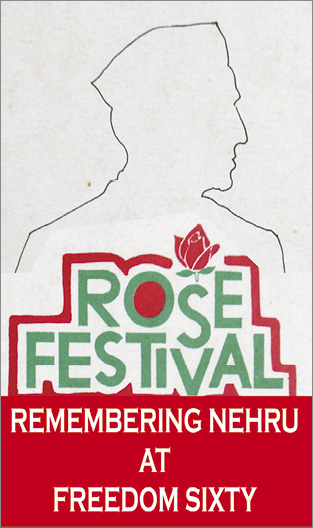
A visual showing a design for a commemorative event to celebrate the 60th year of India’s freedom. The event was called the ROSE FESTIVAL. Nehruji was the first Prime Minister of the independent India. He was fond of roses and always wore one on his achkan.
• Organisation level: Conferences, Visits, Trainings, Annual General Meetings all conducted in any office or institute come under this category.
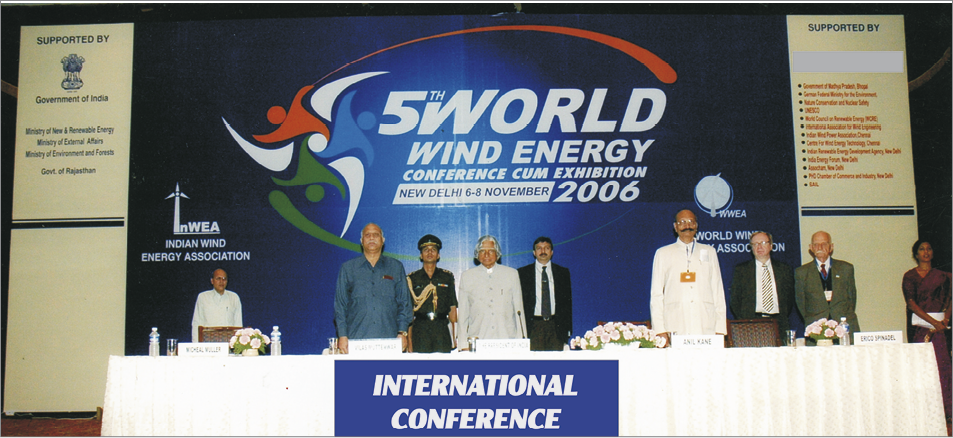
International event like this are hosted by various ministries of the Central Government. They are usually inaugurated and attended by heads of States where a high level of protocol and security is observed.
Launches
These too need advance planning and proper budgeting. Nothing should be done unless the purpose and target to be achieved is clear. Launches could be of different kinds:
• Soft Launch, is when the announcement is not loud and the product or service is introduced into the market quietly.
• Introduction and Brand Awareness
• Market Invasion. This is where all you see everywhere and anywhere is the advertised brand. It is like invading the marketplace with publicity.
Sales
Here of course the product will be sold, it’s a bit different from the rest, but here the product is not being pushed through an advertising campaign. Sales are organised during festivals like Diwali, Eid and Christmas not only in our country, else where in the world too. Sales are mostly for clearance of old stocks (quite the opposite of a launch) before new designs are introduced and usually offer heavy discounts and incentives to the buyers, motivating them to buy the products. So whatever advertising is done, does not speak about the merits of the product instead only invite the readers by flashing things like “buy one get two free’” or “50 per cent Discount till stocks last.”


The catch lies in trying to sell or get rid of as much existing stock as possible, and things sold during such sales usually do not offer any guarantee of quality and service. Even damaged or rejected products are passed off in heavy discounts sometimes helping the not-so-rich to buy branded garments and footwear and other such things.
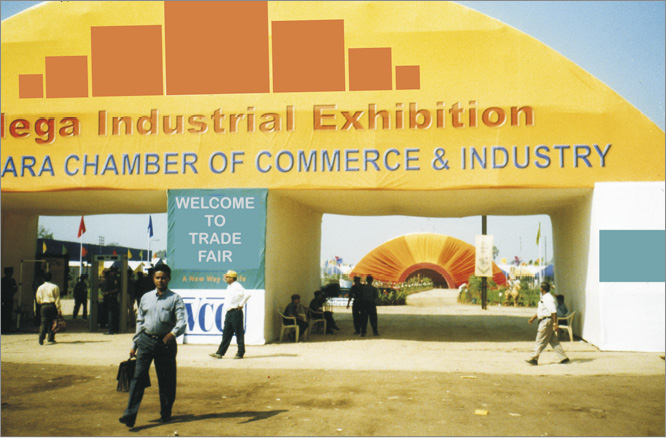
Exhibitions and Trade Fairs
Taking part in any of these needs much advance planning for all or any of these to be a success, first, one must be clear about the purpose of participating and then project the product or services suitably. Remember you may not actually be selling a product sitting there. For participating in Exhibitions and Trade Fairs, the following are of utmost importance, once there is clarity about what is to be achieved:
• Theme, projection and decoration
• Budget allocation
• Attraction, entertainment and public participation
• Necessary permissions for any installations
Publicity
When something is conveyed to the public at large without a defined target audience, in a planned and phased manner by any organised group with a specific purpose it is called publicity. When an idea, message or announcement is purposely made public it is publicity. Business houses, Governments, Political Parties, Non Government Agencies, labour organisations, student’s bodies and other such groups use this method to make known their problems, demands, manifestoes, achievements, activities. Through this activity they try to create a public opinion. Publicity could be positive or negative; it could be for, or against a cause.

Corporate Social Responsibility (CSR)
Corporate Social Responsibility is a form of positive publicity of its own organisation by creating awareness and helping improve living conditions of the community and the society around you and your company or factory and beyond and doing your bit to contribute by actually doing it. Subsequently it helps project the company as a good corporate citizen.
Firstly, it incorporates environment-friendly manufacturing practices, adopting non-polluting technologies, maintaining healthy surroundings, employee welfare schemes, providing medical and educational facilities to nearby villagers and various such things.
Now-a-days these activities have become inevitable as they convey a leading edge corporate strategy which can be communicated effectively through corporate advertising. The company can communicate who they are, what they are and what they stand for. It largely compliments the corporate image change perceptions, attitudes, behaviour – to reality. familiarity through CSR projects leads to favourability, building public awareness and appreciation. It also builds credibility through ethical work culture. Companies should not only talk about doing good they have to do and show it. Eventually CSR communications condition the market place for the sales of the product manufactured by the company.
Activity 1
To understand the objective of political publicity, collect some references and study them.
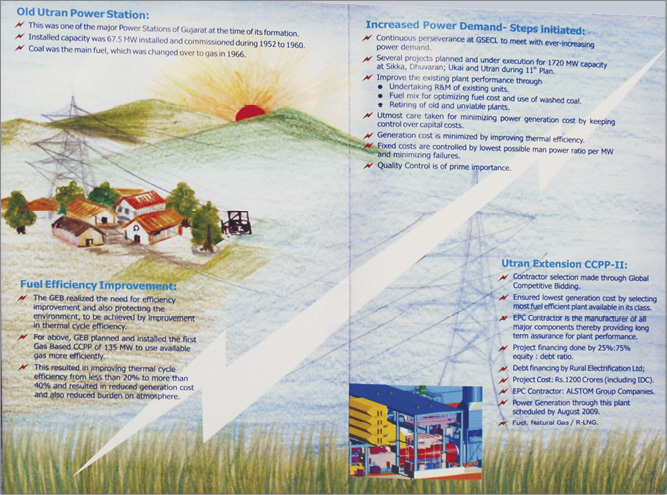
A company generating and distributing electricity could make a literature like this showing their commitment towards rural development
Political
Political publicity is seen during times of elections. The ruling party tries to highlight its achievements during its tenure, by showing how it has tried to fulfill its promises, while the opposition parties leave no stone unturned to undermine the claims of the ruling party. They in turn make promises showing a rosy future if they are voted to power. All parties publicise their agendas and manifestoes. A manifesto is a public declaration of its policies and principles. Each one makes a hero of its leaders. They buy media slots and carry full page newspaper advertisements. We see huge hoardings, posters and even gigantic cut-outs of political figures all over the town. They organise public meetings, rallies and processions to make contact with voters. These all come under political publicity.
Propaganda is another word like publicity, largely means the same, but is used as a harsher term like disseminating a doctrine in order to promote or injure by spreading misleading information or implying things which are concocted and often incorrect. Political parties often use this to down their opponents in public opinion.
Other Public Awareness Programmes
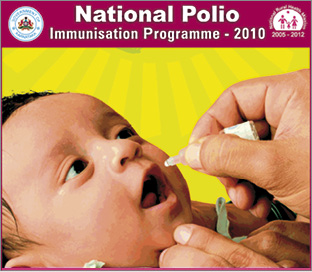
Public Awareness Campaigns are usually of two kinds—
• Government funded for health awareness like Polio eradication, Aids, ORS etc. Also campaigns for Consumer awareness, Right to Information and payment of Income Tax on time come under this.
• For fund raising for a social cause by creating awareness, but these campaigns are floated and funded by Non Government Agencies (NGOs) for their own activities, or for national calamities like floods, draughts, or communal harmony.
The government also occasionally makes use of prominent or popular public figures or actors to promote polio eradication, awareness on aids, crime reporting.
Either the Government pays for its campaigns in the media or it convinces various media houses, newspaper and electronic media owners to become media partners for the social cause.
Public Relations
Public Relations is a management function which evaluates public attitudes, identifies the policies, procedures of an organisation or an individual with the public interest and plans and executes a programme of action to earn public understanding and acceptance.
The fundamental purpose of public relations is to establish a two-way flow of mutual understanding based on truth, knowledge and full information. Public Relations has been defined as the deliberate, planned and sustained effort to establish and maintain mutual understanding between organisation and its public or, the attempt by information, persuasion and adjustment, to engineer public support for an activity, cause, movement or institution. Every known company has attributes like reliability, credibility, stability, prestige, status and market value, like brand image it has to be created, nurtured, and cultivated. In establishing the above objectives the public relations department adopts various methods and media. So every communication is a challenge.
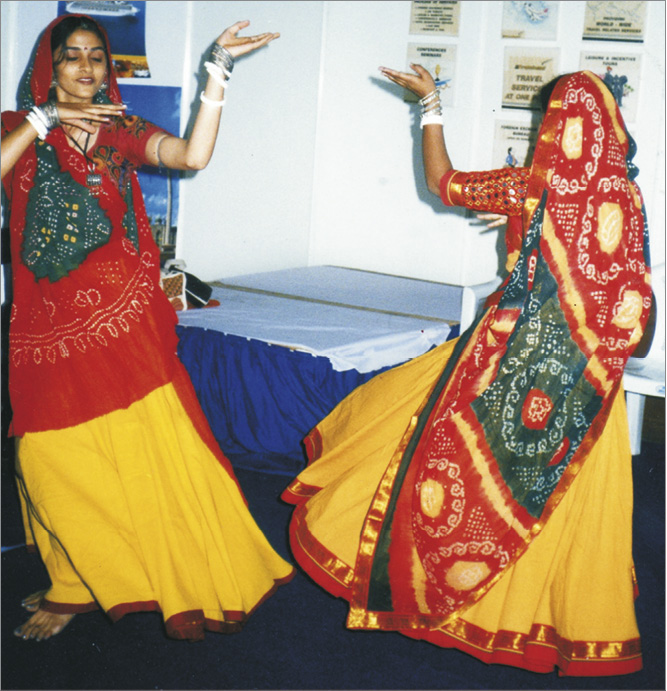

While planning an event, sponsor’s or collaborator’s views have to be kept in mind
Many large advertisers also have a public relations department apart form the advertising department or they have a combined publicity and public-relation department. The ‘Prestige’ or ‘institutional’ advertising is a public relations activity also, aimed at enhancing the public image of an organisation. For example, a company offering scholarships to engineering students, etc. would earn good will from the public. Another method of public relations is to have editorial features or advertisements which resemble editorial features. Some organisations or associations go a step further when they publish a supplement in any leading newspaper to fulfill their Public Relations aims.
Every organisation needs to communicate correctly and positively with these publics and maintain good relations with them using various appropriate methods. The most important of these are the media.
Media
In image building and public relations, CEOs (Chief Executive Officers) and the PROs (Public Relation Officers) are often supported by some media journalists and reporters, and at the same time also opposed by antagonists among, them. Therefore, it is essential to maintain good relations with the media. The work includes issuing of press releases, photographs, organising press conferences, receptions, demonstrations, visits to the factory, etc.
In some situations factors influencing the relations between corporate and media are the linking of advertising support to media coverage and pub1icity. However, the professional view of experts is that the publicity given to a corporation should be solely based on performance and merits of its news value to the reader or viewer of the medium. No other factor should have any influence.
The media today seemingly have a fixation for business news, sometimes in the form of investigative scoops, and other times as interesting features. Corporations and journalists in India particularly have a challenging job to do, and a role to play in development of business. The development and growth of business today, hinges on managing image effectively. In this the role of communications and in particular the writings and reporting by journalists are very important. It puts on a greater responsibility for writing and reporting in depth and accurately on serious development and management issues concerning managing of change. There is a vital need for cordial media relations.
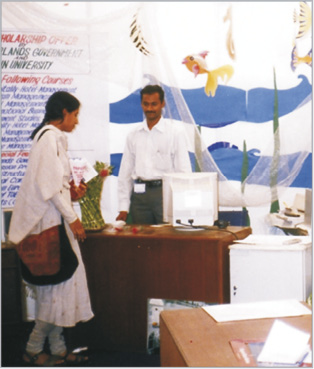
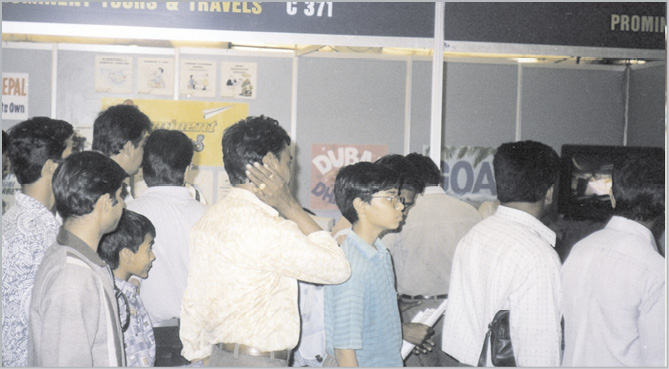
People of all ages throng to exhibitions to get information and scout for best offers

Planning and Designing for these Activities
The purpose of organising any sort of event must be clear. Once that is done then the suitable dates, preferred venue and number of days or duration of program is worked out. If it is a big event many things need to be taken care of for which usually different committees are formed, for example
• Administration • Technical
• Cultural • Hospitality
• Venue • Conference
• Exhibition • Media
• Invitations • Security
• Sponsorships • Accounts
The committees make comprehensive strategic plans for the event. Experts have to constantly be involved in market research so that they can stay in tune with the latest in the business.
The creative teams come up with new and innovative ideas, proposals and properties. The professionals are required to think differently and come up with unique and distinct workable concepts, for print and production. Two dimensional and three dimensional graphic designer are always preferred and employed to create outstanding concepts.
Budgeting and Sponsorships
• Proper cost of all required materials plus other expenses must be first taken into account and a realistic estimate with break-up has to be prepared.
• This list is then re-arranged as per priorities. Some things are a must and can not be eliminated at any cost like the PA or sound system and mikes etc., and some things like floral decorations and bouquets are not indispensable if the budget does not allow or provided for such expenses.
• For the sole purpose of getting sponsors to meet the costs, a segment-wise proposal is made along with the estimated costs. It is then found easier to get the proposal a “Dekho” by a prospective donor. Normally a lumpsum umbrella estimate does not invite fruitful approvals. In the absence of a break-up, the proposed cost gives the impression of being adhoc and unrealistic.
• The detailed proposal should go with a brief covering letter which gives an introduction about the proposed event and how it is exclusive etc. plus how the Donor or the Sponsor is likely to benefit from the association with the event.
Visual Communication and its Impact
Visual communication is actually any kind of expression in visual form, they are normally devoid of details, (everyone is not a great artist) so it becomes a simplified form, carrying only the necessary essence of whatever is being represented in its basic form leading to immediate recall or identification.

With this kind of imagery in public places, people are sure to become health concious. A related healthcare product may be on sale inside the shop, although no brand is mentioned here.
Graphic images are more than descriptive illustrations of things seen or imagined, whose context gives them a unique meaning, and positions lend them a new significance. Their power to create an impact on people cannot be measured easily however, it cannot be underestimated either, it has great powers.
Today we use symbols spontaneously and frequently for effective communication. Symbols draw deeper response with immediate effect. But sometimes there can be a disadvantage because not all understand it, only those who are somewhat familiar will understand.
Every brand now wants to be a “big brand”, whatever the idea, product or service. In totality besides having a classy, meaningful, recallable, well designed LOGO, in turn becomes the projected or perceived personality, which encompassing psychological, emotional, intellectual and Physical characteristics and making it unique.
Corporate Identity
All communication verbal or non-verbal need to be taken seriously and planned strategically and projected methodically. Planned communication with company logo creates a positive image. A logo symbol with or without the name and tag line are known as the “Corporate Identity” of a company or organisation. It is also that part of a company’s image which can be seen, heard or identified with. This means Marketing corporate Image of the Company as the No.1 Product.
The idea is to create up-to-date perceptions, attitudes and behaviour. Image creating exercise can be the leading edge of corporate strategy, helping to
1. build awareness as well as acceptance and a favourable position.
2. redefine the corporate structure after name change,
merger or acquisition, re-structure, investment and disinvestments.
3. pre-sell product in the marketing.
4. establish company’s position before public issues.
5. influence shareholders, investors, financial bodies and the Government.
6. assist in managing critical situations.
7. attract and hold employees.
8. help project the company as a good corporate citizen.
9. image plus brand are the inseparable duo, so can be used to advantage
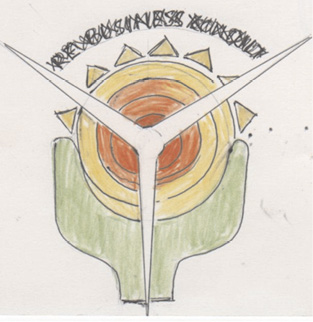
This is how a conceptual visual is developed translating a company’s vision and mission, or core business area. Seen here is a rough design for a company working with a new, renewable and sustainable sources of energy like sun, wind and fossil fuel. It can be further developed into company’s logo and the Corporate Identity
Image is made or projected not by the company’s publicity and ad-campaigns alone, but by its people, by the society around it and by its reputation and status.
Activity 2
Design a corporate identity, begin by doing research on the organisation for which the logo is being created. Use appropriate fonts and colour scheme. You may use graphical elements or initials of the company along with the logotype.
Vision and Mission
Writing of Vision - Mission Statements is an important aspect of Corporate Communications. A mission statement is an explicit statement of values of an organisation. It generates
• the principles in accordance with which the organisation acts.
• the standards with which it is willing to be judged.
As such it is a “security” to ‘’fortune” as it secures and strengthens reputation of a company. Not leaving anything to chance or “default”. It ensures positive results by actually being ‘written’ out.
Activity 3
Based on the vision statement of your school, design a poster to be displayed on the notice board or Principal’s office.
Exercises
1. What do you understand by the term “integrated media”? Why are they named so?
2. Explain how public relation and exhibitions help in marketing a brand.
3. What are the different aspects of planning for different events? Write briefly about any two.
4. What kind of the activities can come under corporate or social responsibilities? List at least five of them.